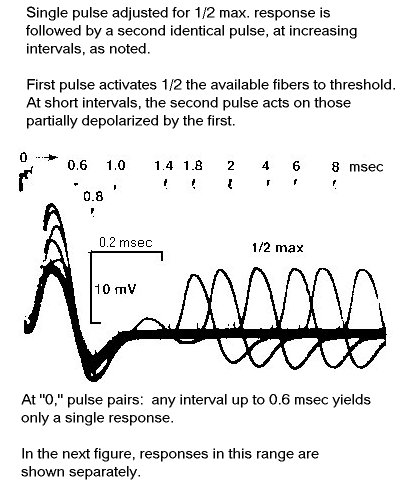The Nerve Impulse Seen from Outside
Dexter M. Easton July 2000 ©
Next topic Previous topic Table of Contents
Topic 27: Condition-testing: local response
When the interval is set to less than about 0.5 to 1 msec, the pairs of pulses evoke only a single spike. That this is true can be seen if the stimulus is set to less than maximal. Then as the interpulse interval is increased from zero up to about 1 msec, the amplitude of the single spike increases to a maximum, falls to the control level, then disappears (Fig. 27A). With further increase, the second spike begins to appear, as in Fig. 26.
Figure 27A. Threshold events: local summation.

By displacing the CRO beam a small distance to the right before each response, we can separate the spikes instead of allowing them to pile up on one another (Fig. 27B). The rise and fall as the interpulse interval is increased can then be plotted as a function of the interval.
Figure 27B. Time course of "local repsonse."

In order to get an impulse started, sufficient charge has to be delivered during a short time. A very small short-duration pulse may alone be insufficient, but a second pulse delivered quickly thereafter can bring the membrane to the critical level for excitation. Adjust the CRO sweep speed to 0.5 or 1 msec/div. With stimulus duration at 0.1 msec, adjust the stimulus intensity to obtain an A fiber peak 0.3-0.5 of maximum. Set the stimulator on twin pulses.
Now obtain successive responses with interpulse intervals at 0.2, 0.4, 0.6, 0.8, 1.0 msec. Though two stimuli are delivered, only one response is obtained for each pair. The response is smaller for the shorter and the longer intervals and is maximal at an intermediate interval. The first pulse stimulates some fibers (say half of the total available) to threshold. The charge placed on the other fibers is subthreshold but can be added to by the second shock delivered soon enough. If this addition occurs within the critical interval, the otherwise subthreshold excitation reaches threshold. If the second pulse comes too late, the effect from the first has worn off, and only the control half of the potentially available AP will be seen.
Next topic Previous topic Table of Contents

